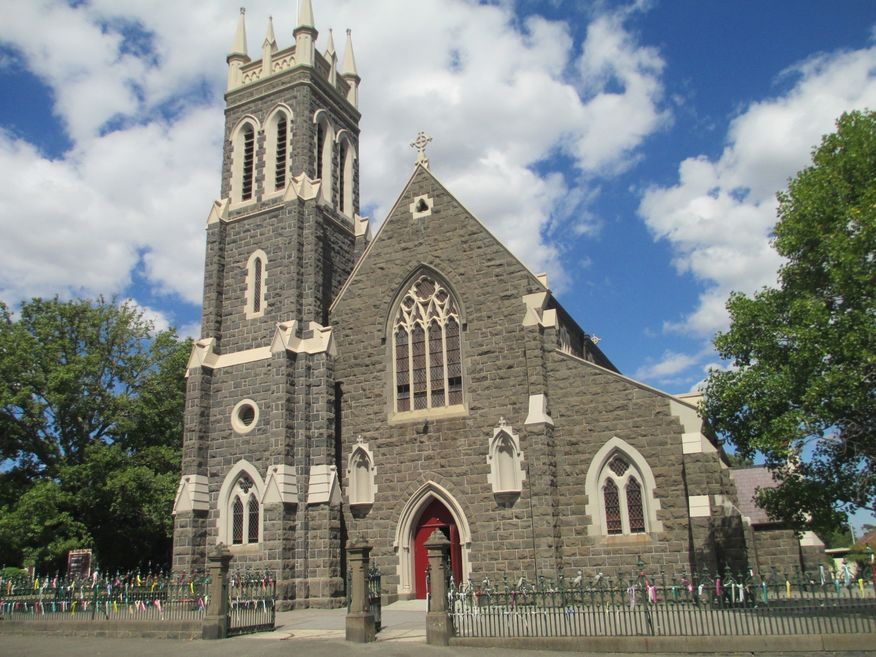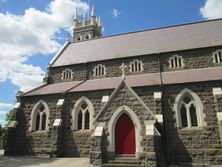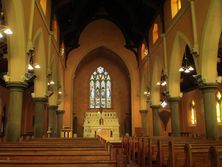A-B Towns | C-E Towns | F-K Towns | L-M Towns | N-S Towns | T-Z Towns | All Towns
St Alipius Catholic Church
Ballarat East, VIC 3350
Church Information
| Church Name: | St Alipius Catholic Church |
| Church Previous Name: | - |
| Denomination: | Catholic Church in Australia |
| Street Address: | 82 Victoria St, Ballarat East VIC 3350, Australia |
| Suburb: | Ballarat East |
| State: | VIC |
| Postcode: | 3350 |
| Foundation Stone Laid: | unknown |
| Foundation Stone Notes: | No Foundation Stone details are known, but a commemorative stone records: A M D G - This Memorial Stone - to commemorate the completion of - St Alipius Church - was laid by - The Right Rev D Foley DD - Bishop of Ballarat - on Sunday 14th December 1924. |
| Date Opened: | 14-12-1924 |
| Date Closed: | unknown |
| Email: | admin@churchesaustralia.org |
Comments
The St Alipius Catholic Church, Ballarat is part of the Parish of Ballarat East and the Diocese of Ballarat. It had its beginnings in the Ballarat Gold Rush that started in August 1851. As thousands flocked to the diggings, Father Parrick Dunne celebrated the first Mass in October 1851. The present church building was opened on 14/12/1924, by the Bishop of Ballarat. [The following provided by Jason Fletcher, liturgy coordinator].'The church building is 150 years old this year [2024], so we've been looking into its history. Starting from oldest to most recent, here are some of the key events in the history of St Alipius Church that I’ve been able to identify: In 1851 Fr Mathew Downing arrived on the Ballarat Goldfields and set up his tent 100m east of where the Brown Hill Hotel is located. He named his parish St Alipius in 1852. In February 1853 Fr Downing moved to the present St Alipius site and erected a canvas church, like the one at Sovereign Hill. The first Ballarat baptism was also in February that year, with the first marriage on 22 March. The church was consecrated by Bishop James Alipius Goold on 27 November 1853. On 2 December 1854, St Alipius’ parish priest, Fr Patrick Smyth, visited the Eureka Stockade and tried to convince the rebels to go home and attend mass in the morning. When fighting broke out before dawn the next day, he rode to the stockade and administered the last rites to the men who lay dying. He helped Peter Lalor escape. Peter Lalor’s arm was amputated in Fr Smyth’s tent the next day and his arm was buried. Fr Smyth and St Alipius parishioners helped Peter Lalor evade capture by smuggling him to Geelong. In 1857 the canvas church and presbytery were replaced by weatherboard buildings. The wooden church was later moved to Hopetoun Street and used as a boys' school. In 1863 the first choir was established at St Alipius. On 2 March 1873, the foundation stone for the current St Alipius Church was laid by Bishop Goold. In 1874 the current St Alipius Church opened. On 25 May 1889, the stations of the cross in St Alipius were blessed. In 1905 the presbytery was opened. In 1908 the choir gallery was constructed and accessed by the cast iron spiral staircase. In 1912 the Fincham Organ, funded by Count Sir Thomas O’Loughlin a “Papal Knight” from Warrenheip, was installed. The Ballarat East Conference of St Vincent de Paul was formed at St Alipius on 4 August 1913. In 1924 significant alterations and additions were made to the St Alipius church including the erection of the bell tower, two bays added to the nave and aisles, and the wooden chancel and sacristies were rebuilt in bluestone. The cast iron fence, which had formerly been at the Ballarat Base Hospital, was installed. A foundation stone for the new work was laid by Bishop D Foley. The renovated church was opened on 14 December 1924. In 1944 the marble altar along the front wall was installed. In 1947 the stained-glass window was installed in the chancel. The altar and the windows were dedicated to the pioneers of the parish. In 1968 the front altar was installed, and the altar platform was extended to accommodate it. In 1978 additional changes were made including further extending the altar platform, alterations to the rear altar, installation of a marble top and glass base to the front altar, and construction of an entrance foyer under the choir loft. The entrance foyer was given a concrete floor, with the rest of the church having a plywood floor system placed on the timber floor and burgundy carpet laid. The timber pews were refurbished.' More historical information/phoographs of the church/congregation are invited. Photographs uploaded 11/3/2017.





